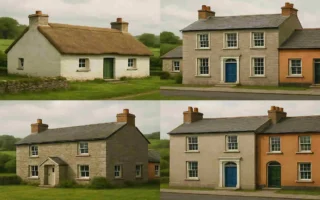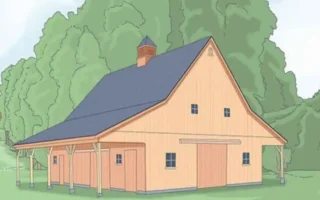Bi-level homes have long captivated homeowners with their distinctive architecture and clever use of space. Characterized by two separate levels connected by short flights of stairs—with the main entrance typically situated between them—these homes offer a unique layout that blends privacy, functionality, and style. The design maximizes interior space on smaller lots and creates a natural separation between living and sleeping areas, making it an ideal choice for families and entertainers alike. As interest in flexible, efficient home layouts grows, bi-level homes are experiencing a revival, celebrated for their adaptability and enduring charm.
What is a Bi-Level Home?
A bi-level home is a distinctive architectural design characterized by its split-level layout. Typically, these homes feature two separate living areas divided by a few steps, creating an inviting and functional space.
Upon entering, you’ll usually find the main level with common areas like the living room and kitchen. The upper floor often houses bedrooms and bathrooms, providing privacy for a restful retreat.
The lower level can serve various purposes — extra bedrooms, recreational spaces, or even in-law suites. This versatility adds to their appeal.
Bi-level homes are particularly popular among families. They strike a balance between open-concept designs and defined spaces. With their unique structure, they offer charm and practicality that many homeowners appreciate.
History and Origin of the Bi-Level Design
The bi-level home design emerged in North America during the mid-20th century. It became particularly popular in suburban areas during the post-World War II housing boom.
Architects sought to maximize space while catering to growing families and changing lifestyles. The bi-level design offered a clever solution by combining two levels, allowing for privacy and shared living spaces.
This style house features an entrance that leads to a landing with stairs going up and down, which was innovative at the time. Homeowners appreciated how it provided distinct zones for relaxation and entertainment without sacrificing square footage.
As the years progressed, variations of this house design have evolved but retained their core charm. Today, these homes are celebrated not only for their unique aesthetics but also for their functionality within diverse family dynamics.
Unique Features of Bi-Level Homes

Bi-level homes stand out for their distinctive architectural design. They typically feature two levels, each partially above ground. This unique layout creates a spacious feel without the need for extensive foundations.
One notable aspect is the split entryway. Upon entering, you can either ascend to the upper level or descend to the lower level. This design maximizes space and enhances flow throughout the modern home.
Large windows are another hallmark of bi-level houses. These allow natural light to flood both levels, creating an airy ambiance many homeowners cherish.
Outdoor access is convenient from both floors, offering easy transitions between indoor and outdoor living areas while enhancing the overall experience of your surroundings.
Advantages and Disadvantages of Living in a Bi-Level Home

Living in a bi-level home offers distinct advantages. The layout separates living and sleeping areas, which is ideal for families. This design often features large windows that fill the space with house natural light, creating an inviting atmosphere.
On the other hand, these homes usually offer more square footage than single-story house designs at similar price points, making them appealing to budget-conscious buyers looking for spaciousness without breaking the bank.
Tips for Decorating and Organizing a Bi-Level Home

Decorating a bi-level home can be both exciting and challenging. Embrace the unique house layout by utilizing each level effectively. Use light, neutral colors on the walls to create an airy feel that enhances natural light.
Consider open shelving in common areas. This adds visual interest while keeping items organized and accessible. Incorporate house mirrors strategically; they can make spaces appear larger and brighter.
When it comes to furniture, opt for pieces that fit well within the space without overwhelming it. Multi-functional furniture like ottomans with storage can be particularly beneficial.
Area rugs help define spaces, especially in open-concept living rooms or dining areas. Choose patterns or textures that reflect your style while complementing other decor elements.
How to Make the Most out of Limited Space in a Bi-Level Home

Strategic planning is key to maximizing limited space in a bi-level home. Start by utilizing vertical space. Install shelving units that reach the ceiling. This adds storage and draws the eye upwards, creating an illusion of height.
Consider multi-functional furniture to enhance usability without cluttering your living areas. A coffee table with built-in storage can neatly house items while serving its primary function. Choose beds with drawers underneath for extra linens or seasonal clothing in bedrooms.
Use color wisely; light shades house make rooms feel larger and more open. Mirrors are your best friends in smaller spacesthey reflect light and create depth, making any area appear more expansive.
Room dividers can help define spaces without closing them off completely. For example, a stylish bookcase could separate a small office nook from the living room while keeping things airy.
FAQ: What is a Bi-Level House?
What is a bi-level house?
A bi-level house, also called a split-entry home, is a type of house design where the front door opens to a small landing or foyer. From there, you can either go upstairs to the main living area or downstairs to a lower level.
What are the key features of a bi-level house?
- Two distinct levels: One level is partially below ground (lower level), and the other is above.
- Split entry: A small entryway or landing divides the stairs going up and down.
- Compact footprint: Designed to maximize space efficiently on smaller lots.
- Lower level use: Often used for bedrooms, recreation rooms, or additional living spaces.
How is a bi-level house different from a split-level house?
A bi-level house has only two levels connected by a short staircase.
A split-level house usually has three or more levels, with staggered floors connected by short staircases.
What are the advantages of a bi-level house?
- Efficient space use on smaller lots.
- Often more affordable than other styles.
- Lower level provides flexibility for additional living spaces.
- Large windows for natural light in both levels.
What are the disadvantages of a bi-level house?
- Limited entryway space.
- Stairs are unavoidable, making it less ideal for people with mobility issues.
- Lower-level rooms may feel less bright if they’re partially below ground.




